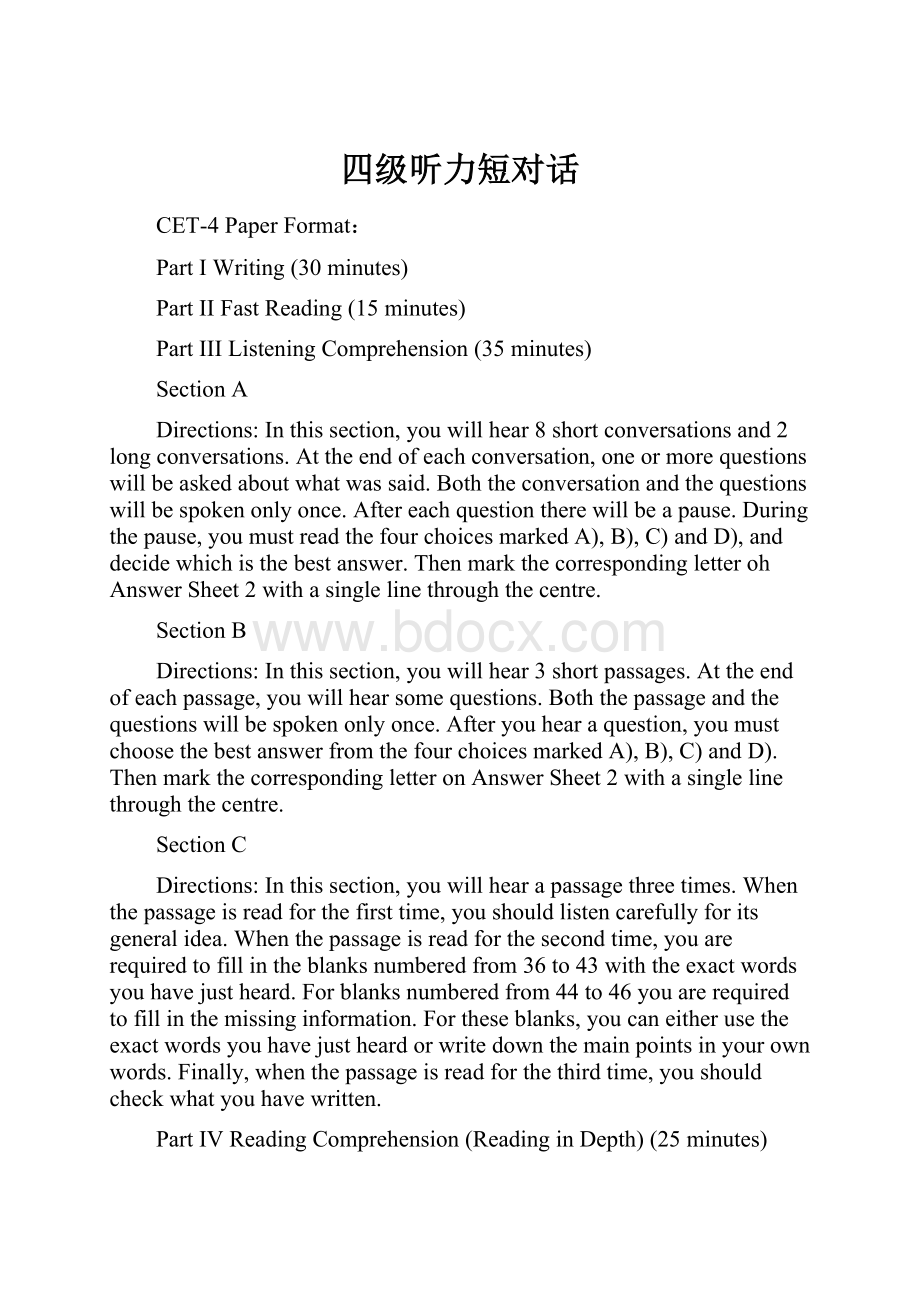四级听力短对话.docx
《四级听力短对话.docx》由会员分享,可在线阅读,更多相关《四级听力短对话.docx(36页珍藏版)》请在冰豆网上搜索。

四级听力短对话
CET-4PaperFormat:
PartⅠWriting(30minutes)
PartIIFastReading(15minutes)
PartIIIListeningComprehension(35minutes)
SectionA
Directions:
Inthissection,youwillhear8shortconversationsand2longconversations.Attheendofeachconversation,oneormorequestionswillbeaskedaboutwhatwassaid.Boththeconversationandthequestionswillbespokenonlyonce.Aftereachquestiontherewillbeapause.Duringthepause,youmustreadthefourchoicesmarkedA),B),C)andD),anddecidewhichisthebestanswer.ThenmarkthecorrespondingletterohAnswerSheet2withasinglelinethroughthecentre.
SectionB
Directions:
Inthissection,youwillhear3shortpassages.Attheendofeachpassage,youwillhearsomequestions.Boththepassageandthequestionswillbespokenonlyonce.Afteryouhearaquestion,youmustchoosethebestanswerfromthefourchoicesmarkedA),B),C)andD).ThenmarkthecorrespondingletteronAnswerSheet2withasinglelinethroughthecentre.
SectionC
Directions:
Inthissection,youwillhearapassagethreetimes.Whenthepassageisreadforthefirsttime,youshouldlistencarefullyforitsgeneralidea.Whenthepassageisreadforthesecondtime,youarerequiredtofillintheblanksnumberedfrom36to43withtheexactwordsyouhavejustheard.Forblanksnumberedfrom44to46youarerequiredtofillinthemissinginformation.Fortheseblanks,youcaneitherusetheexactwordsyouhavejustheardorwritedownthemainpointsinyourownwords.Finally,whenthepassageisreadforthethirdtime,youshouldcheckwhatyouhavewritten.
PartIVReadingComprehension(ReadinginDepth)(25minutes)
SectionA
SectionB
PartVCloze(15minutes)
PartVITranslation(5minutes)
四级听力短对话
一、按命题规律分类
① 推断(分细节推断、综合推断)题型(虚拟语气;行为方式、原因;说话人观点态度;言外之意;
说话人语气→也可称重复反问)
② 含but题型
③ 明示信息题(havesth.done结构;关键词;同义替换)
④ 建议题型
⑤ 隐含否定题型
⑥ 场景判断题型
⑦ 判断人物身份、职业题型
⑧ 判断人物关系题型
⑨ 数字(时间、价格等)运算题型
二、按题材分类
听力对话的题材十分广泛,但以贴近学生生活、学习的话题为主。
考生在熟悉每个话题时,应重点熟悉相关话题的常用词语,以便在听音时能有效捕捉关键词。
对话中的常见话题可以归纳为以下八种:
1.学校生活:
有关课程、考试、作业、借书、实验、求教、实习等方面的话题。
如:
W:
Ihadtodealwithsomanycourseslastterm,butIreallyhadahardtime.
M:
Itoldyouitwouldbebetterforyouifyoutookfewercoursesduringthefirstsemester.
2.旅游交通:
有关参观、游览、乘车、登机、海关检查等方面的内容。
如:
W:
IamthinkingofgoingtoAustinforavisit.Doyouthinkit’sworthseeing?
M:
Well,IwishIhadbeenthere.
3.饮食娱乐:
内容涉及餐饮、聚会、游泳、球赛、影视等。
如:
W:
Haveyouatableforfour?
M:
Certainly,Sir.Acornertableorwouldyouratherbenearthewindow?
4.宾馆住房:
主要涉及房屋租用、房间预订等内容。
如:
W:
Idon’tthinkwecanfindabetterhotelaroundhereatthistime.
M:
Let’swalkalittlefurthertoseeifthereisanotherone.Ijustcan’tbearthetrafficnoisehere.
5.工作状况:
主要涉及求职、面试、职务提升、工资待遇等方面的内容。
如:
W:
IfIwereyou,Iwouldhaveacceptedthejob.
M:
Iturneddowntheofferbecauseitwouldmeanfrequentbusinesstripsawayfrommyfamily.
6.卫生环境:
内容涉及气候、温度、环境卫生、疾病、就医等。
如:
M:
Hello,Mrs.White,whatcanIdoforyou?
W:
Idon’tknowwhat’sthematterwithme.Iamalwaysfeelingtired.Iamusuallywornoutattheendoftheday.
7.装饰维修:
包括房屋装修、设备安装、检测修理等。
如:
M:
Didyoucheckthepowerplugandpresstheplaybutton?
W:
Yes,thepowerindicatorwason,anditwasrunning,butsomehowthesounddidn’tcomethrough.
8.日常生活:
内容包括活动安排、人际交往、购物消费等。
如:
W:
IoftenmistakeJimforBob.Canyoutellthemapart?
M:
No,theylooksomuchalikethattheyevenconfusedtheirmothersometimeswhentheywereyoung.
三、按对话内容的表达方式分类
四级听力对话从内容的表达方式上可分为六种:
(一)直陈表达—说话人用直陈语气,直接表达事实或自己的观点、态度等。
说话人的真实态度或意图可以从正面进行理解。
如:
M:
Charlesenjoyedhistwo-weekdrivethroughSouthChina.
W:
Yes,hesaidthathesawmuchmorethanhewouldhavetravelingbybusortrain.
Q:
HowdidCharlestravel?
A)Bycar. 同义转述是解 B)Bybus.(直接排除)
C)Byplane.(未提到) D)Bytrain.(直接排除)
答案为A)。
(二)否定表达—说话人以否定的方式表达肯定的意思(如果以否定的方式表达否定的意思,则为直陈表达);说话人的态度往往较为强烈,语气十分肯定。
如:
M:
Ithinkit’shightimeweturnedourattentiontothedangerofdrunkdrivingnow.
W:
Ican’tagreewithyoumore.Yousee,countlessinnocentpeoplearekilledbydrunkdriverseachyear.
Q:
Whatdoesthewomanmean?
A)Mostpeoplekilledintrafficaccidentsareheavydrinkers.
B)Shedoesnotagreewiththeman.
C)Drunkdriversarenotguilty.
D)Peopleshouldpaymoreattentiontothedangerofdrunkdriving.
答案为D)。
(三)祈使表达—以祈使句形式表达自己的意见、建议或意愿;祈使句的形式可以是肯定的,也可以是否定的。
如:
W:
Themoviestartsin5minutesandthere’sboundtobealongline.
M:
Whydon’twecomebackforthenextshow?
I’msureitwouldbelesscrowded.
Q:
Whatisthemansuggesting?
A)Comingbackforalatershow.
B)Waitinginaqueue.
C)Comingbackinfiveminutes.
D)Notgoingtothemovietoday.
答案为A)。
whynot句式表建议。
(四)虚拟表达—以虚拟语气的形式表达自己的态度或建议;所表达的真实意思往往与语句的表面意思相反。
如:
W:
Ifithadn’tbeensnowingsohard,Imighthavebeenhomeby9o’clock.事实与之相反
M:
It’stoobadyoudidn’tmakeit.Janewashereandshewantedtoseeyou.
Q:
Whathappenedtothewoman?
A)Shegothomebefore9o’clock.
B)Shehadabadcold.
C)Shehadacaraccident.
D)Shewasdelayed.
答案为D)。
与过去事实相反的虚拟语气。
(五)重复反问—对上文中的主要信息词进行重复并提出反问;所表达的意见或态度往往与上文相反。
如:
M:
Let’sseeifthebasketballgamehasstartedyet.
W:
Started?
Itmustbeclearwhoiswinningbynow. 反问表否定·答案在下文
Q:
Whatdoesthewomanmean?
A)Sheissurewhoisgoingtowin.
B)Nowitisagoodtimetostartthegame.
C)Thegamehasbeengoingonforalongtime.
D)Thesameteamalwayswins.
答案为C)。
注意第二说话人(本题为女士)的说话的口气和内容。
(六)转折表达—先说明原本的意图或情势,经But/instead/rather等转折后,再说明后来的实际想法或事实结果,即人们常说的中but句型。
设题点往往在转折词之后。
如:
M:
IhopeyouwillspendChristmaswithus.
W:
I’dloveto,butJackandIaregoingtoAustralia.We’llsendyoupostcardsfromthere.(否定转折·答案在下文/与上文;相反的是解)
Q:
Whatdowelearnfromthisconversation?
A)Thewomandoesn’twanttospendChristmas.
B)ThewomanisgoinghomeforChristmas.
C)ThewomanhasnotbeeninvitedtotheChristmasparty.
D)ThewomanisgoingtospendChristmasabroad.
答案为D)。
先说I’dloveto,表愿意,后由but转折后,说明要和Jack去澳大利亚(国外)的实际想法。
了解谈话内容的表达方式对答案的摄取往往起着十分重要的作用。
四、按答案的摄取方式分类
按照答案的摄取方式,可以将听力对话题分为四种类型:
(一)直摄型—从原文中可以直接找到答案。
如:
M:
IwonderifSuzywillbeherebyfiveo’clock.
W:
Herhusbandsaidshelefthomeat4:
30.Sheshouldbehereat5:
10,and5:
15atthelatest.
Q:
WhattimedidSuzyleavehome?
选择距离关键词最近的时间
A) 5:
15
B) 5:
10
C) 4:
30
D) 5:
00
答案为C)。
女士说:
Sue的丈夫说她四点半就从家里出来了。
此题考查考生对几个不同的时间表达的辨别能力。
答案在原文中直接出现,可直接摄取。
(二)解释型—正确选项是对对话中关键词语的同义转述。
如:
M:
IamworriedaboutthoseclassesmissedwhenIwassick.
W:
I’llbringyouuptodateonwhatwe’vedone.
Q:
Whatdoesthewomanmean?
A) She’sbroughtthemanapairofglassestoday.
B) Shewillhelpthemantocatchup.同义转述
C) Sheisworriedabouttheman’shealth.
D) Shehasboughtthemananup-to-datemap.
答案为B)。
答案中的helpthemantocatchup是女士所说的bringyou(theman)upon“使赶上/补上”的同义转述。
考生须理解原文的含义,并找到相对应的同义表达,才能作出答案。
(三)计算型—答案需经过计算得来。
在大多数情况下,计算题都与时间或价格有关,所以考生要熟悉有关时间和价格的表达方式,如“半价”、“打折”等等,还要注意不同情况下价格的变化,比如成对买或大人与小孩票价的不同等等。
如:
W:
Here’sa10-dollarbill,givemetwoticketsfortonight’sshowplease.
M:
Sure.Twoticketsandhere’s$1,40change.
Q:
Howmuchdoesoneticketcost?
(10.00-1.40)/2=4.30
A)$1.40 B)$4.30 C)$6.40 D)$8.60
答案为B)。
对于此类题一定要注意各种数据之间的关系。
本题中女士付10美元给男士,买两张票。
男士找回1.40美元。
问一张票多少钱?
(四)推理型—问题所要求的答案不能从原文中直接摄取,需经过推理才能得出。
如:
M:
Ispentsomuchtimepolishingmyletterofapplication.
W:
It’sworthwhiletomaketheeffort.Youknowjusthowimportantitistogiveagoodimpression.
Q:
Whatdoweknowabouttheman?
A)Hewantstogetanewposition.
B)Heisaskingthewomanforhelp.
C)Hehasleftthewomanagoodimpression.听到的不是解 D)Heenjoysletterwriting.
答案为A)。
男士话语中的letterofapplication和女士话语中giveagoodimpression都是申请职位最典型的词语,两者都以隐含的形式暗示男士要申请一个职位。
如果考生不综合两处的意思,就很容易误选其他选项。
与直摄型试题相对,推理题在四级听力对话部分中出现得越来越多,需考生给予特别的关注。
五、按答案的内容与性质分类
由于考生在做题时所能直接控制的只有四个选项,而选项的内容又直接与对话内容有关,且在许多情况下,可以利用选项分析技巧由选项内容推知对话内容,所以按答案内容进行的分类对考生来说是最有现实意义的。
以答案内容为标准,可以将对话题分为八种:
1.谈论话题型—答案内容是对话中所谈论的话题或对象;
提问方式通常为:
Whataretheytalkingabout?
Whatarethespeakerstalkingabout?
话题涉及范围较广,但每次考试出题数量最多不会超出2个。
如:
M:
Iwasterriblyembarrassedwhensomeoftheaudiencegotupandleftinthemiddleoftheperformance.同义转述
W:
Well,somepeoplejustcan’tseemtoappreciatereal-lifedrama.同义转述
Q:
Whataretheytalkingabout?
利用关键词捕捉技巧
[A]Amovie.
[B]Alecture.
[C]Aplay.
[D]Aspeech.
答案为[C]。
performance“表演”,real-lifedrama(=play)“现实剧”。
2.对话场景题—要求回答对话发生的场合或地点。
提问方式通常为:
Whereistheconversationmostprobablytakingplace?
Wheredid/doestheconversationmostprobablytakeplace?
Wherearethetwopeople?
常见对话场景:
学校(教室)、医院(诊所)、机场、车站、邮局、餐馆、图书馆、美术馆、商店、警察局等;此类题型在对话中较常见,可以分为以下两种:
1) 多个地点选一个:
对话中提到几个场所,就其中某一个进行提问,解题的关键在于区分细节,把握提问中的关键词。
例1:
M:
Hello,thisisJohnHopkinsattheRiversideHealthCentre.I'dliketospeaktoMr.Jones.
W:
I'msorry.Mr.Hopkins.Myhusbandisn'tathome.ButIcangiveyouhisofficephonenumber.Hewon'tbebackuntilsixo'clock. 推理题
Q:
WheredoesMrs.Jonesthinkherhusbandisnow?
A) Athome.
B) Attheriverside.
C) Atthehealthcenter.
D) Athisoffice.
答案为D)。
此处提到三个地点,考生在听音时应看着四个选项,辨清谁在哪个地点,同时抓住关键词语isn’tathome,officephonenumber,won’tbebackuntilsixo’clock.。
2)根据上下文推断:
对话中并未提到场所,但问题要求根据对话内容推测出谈话场所,或某人的去向。
这种题型要求考生能抓住关键的信息词,即与特定地点有关联的最常用词或词组。
如:
M:
Excuseme.I’dliketoplaceanadvertisementforausedcarintheSundayeditionofyourpaper.
W:
OK.Butyouhavetorunyouradvertisementallweek.Wecan’tcalltheratesforjustSunday.
Q:
Whereistheconversationmostprobablytakingplace?
[A]Atanews-stand.
[B]Atacardealer’s.
[C]Atapubli